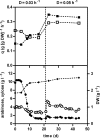Novel evolutionary engineering approach for accelerated utilization of glucose, xylose, and arabinose mixtures by engineered Saccharomyces cerevisiae strains
- PMID: 19074603
- PMCID: PMC2643596
- DOI: 10.1128/AEM.02268-08
Novel evolutionary engineering approach for accelerated utilization of glucose, xylose, and arabinose mixtures by engineered Saccharomyces cerevisiae strains
Abstract
Lignocellulosic feedstocks are thought to have great economic and environmental significance for future biotechnological production processes. For cost-effective and efficient industrial processes, complete and fast conversion of all sugars derived from these feedstocks is required. Hence, simultaneous or fast sequential fermentation of sugars would greatly contribute to the efficiency of production processes. One of the main challenges emerging from the use of lignocellulosics for the production of ethanol by the yeast Saccharomyces cerevisiae is efficient fermentation of D-xylose and L-arabinose, as these sugars cannot be used by natural S. cerevisiae strains. In this study, we describe the first engineered S. cerevisiae strain (strain IMS0003) capable of fermenting mixtures of glucose, xylose, and arabinose with a high ethanol yield (0.43 g g(-1) of total sugar) without formation of the side products xylitol and arabinitol. The kinetics of anaerobic fermentation of glucose-xylose-arabinose mixtures were greatly improved by using a novel evolutionary engineering strategy. This strategy included a regimen consisting of repeated batch cultivation with repeated cycles of consecutive growth in three media with different compositions (glucose, xylose, and arabinose; xylose and arabinose; and only arabinose) and allowed rapid selection of an evolved strain (IMS0010) exhibiting improved specific rates of consumption of xylose and arabinose. This evolution strategy resulted in a 40% reduction in the time required to completely ferment a mixture containing 30 g liter(-1) glucose, 15 g liter(-1) xylose, and 15 g liter(-1) arabinose.
Figures




Similar articles
-
Establishment of L-arabinose fermentation in glucose/xylose co-fermenting recombinant Saccharomyces cerevisiae 424A(LNH-ST) by genetic engineering.Appl Microbiol Biotechnol. 2010 Aug;87(5):1803-11. doi: 10.1007/s00253-010-2609-0. Epub 2010 May 7. Appl Microbiol Biotechnol. 2010. PMID: 20449743
-
Fermentation of glucose-xylose-arabinose mixtures by a synthetic consortium of single-sugar-fermenting Saccharomyces cerevisiae strains.FEMS Yeast Res. 2018 Dec 1;18(8). doi: 10.1093/femsyr/foy075. FEMS Yeast Res. 2018. PMID: 30010916
-
Engineering of Saccharomyces cerevisiae for efficient anaerobic alcoholic fermentation of L-arabinose.Appl Environ Microbiol. 2007 Aug;73(15):4881-91. doi: 10.1128/AEM.00177-07. Epub 2007 Jun 1. Appl Environ Microbiol. 2007. PMID: 17545317 Free PMC article.
-
Engineering of Saccharomyces cerevisiae for the efficient co-utilization of glucose and xylose.FEMS Yeast Res. 2017 Jun 1;17(4). doi: 10.1093/femsyr/fox034. FEMS Yeast Res. 2017. PMID: 28582494 Review.
-
Stress-related challenges in pentose fermentation to ethanol by the yeast Saccharomyces cerevisiae.Biotechnol J. 2011 Mar;6(3):286-99. doi: 10.1002/biot.201000301. Epub 2011 Feb 9. Biotechnol J. 2011. PMID: 21305697 Review.
Cited by
-
The genetic basis of variation in clean lineages of Saccharomyces cerevisiae in response to stresses encountered during bioethanol fermentations.PLoS One. 2014 Aug 12;9(8):e103233. doi: 10.1371/journal.pone.0103233. eCollection 2014. PLoS One. 2014. PMID: 25116161 Free PMC article.
-
Improved glycerol utilization by a triacylglycerol-producing Rhodococcus opacus strain for renewable fuels.Biotechnol Biofuels. 2015 Feb 26;8:31. doi: 10.1186/s13068-015-0209-z. eCollection 2015. Biotechnol Biofuels. 2015. PMID: 25763105 Free PMC article.
-
Adaptive Laboratory Evolution Restores Solvent Tolerance in Plasmid-Cured Pseudomonas putida S12: a Molecular Analysis.Appl Environ Microbiol. 2021 Apr 13;87(9):e00041-21. doi: 10.1128/AEM.00041-21. Print 2021 Apr 13. Appl Environ Microbiol. 2021. PMID: 33674430 Free PMC article.
-
Leveraging transcription factors to speed cellobiose fermentation by Saccharomyces cerevisiae.Biotechnol Biofuels. 2014 Aug 27;7(1):126. doi: 10.1186/s13068-014-0126-6. eCollection 2014. Biotechnol Biofuels. 2014. PMID: 25435910 Free PMC article.
-
Simultaneous saccharification and co-fermentation for bioethanol production using corncobs at lab, PDU and demo scales.Biotechnol Biofuels. 2013 Jan 14;6(1):2. doi: 10.1186/1754-6834-6-2. Biotechnol Biofuels. 2013. PMID: 23311728 Free PMC article.
References
-
- Andreasen, A. A., and T. J. Stier. 1953. Anaerobic nutrition of Saccharomyces cerevisiae. I. Ergosterol requirement for growth in a defined medium. J. Cell Physiol. 41:23-36. - PubMed
-
- Andreasen, A. A., and T. J. Stier. 1954. Anaerobic nutrition of Saccharomyces cerevisiae. II. Unsaturated fatty acid requirement for growth in a defined medium. J. Cell Physiol. 43:271-281. - PubMed
-
- Aristidou, A., and M. Penttilä. 2000. Metabolic engineering applications to renewable resource utilization. Curr. Opin. Biotechnol. 11:187-198. - PubMed
-
- Attfield, P. V., and P. J. L. Bell. 2006. Use of population genetics to derive nonrecombinant Saccharomyces cerevisiae strains that grow using xylose as a sole carbon source. FEMS Yeast Res. 6:862-868. - PubMed
Publication types
MeSH terms
Substances
LinkOut - more resources
Full Text Sources
Other Literature Sources
Molecular Biology Databases

